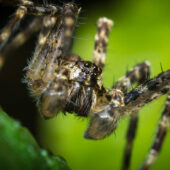WFU awards and recognitions briefs
 The WFU Awards and Recognitions briefs celebrate milestones of faculty, staff and students at Wake Forest.
The WFU Awards and Recognitions briefs celebrate milestones of faculty, staff and students at Wake Forest.Categories: Alumni, Awards & Recognition, Research & Discovery
 The WFU Awards and Recognitions briefs celebrate milestones of faculty, staff and students at Wake Forest.
The WFU Awards and Recognitions briefs celebrate milestones of faculty, staff and students at Wake Forest.Categories: Alumni, Awards & Recognition, Research & Discovery
 In people with chronic malaria, certain metabolic systems in the blood change to support a long-term host-parasite relationship, a finding that is key to eventually developing better detection, treatment and eradication of the disease, according to research published today in the Journal of Clinical Investigation Insight.
In people with chronic malaria, certain metabolic systems in the blood change to support a long-term host-parasite relationship, a finding that is key to eventually developing better detection, treatment and eradication of the disease, according to research published today in the Journal of Clinical Investigation Insight.Categories: Research & Discovery
 Wake Forest University has appointed Jonathan L. Walton as Dean of the School of Divinity. Walton is currently at Harvard, where he serves as the Plummer Professor of Christian Morals and Pusey Minister in the University’s Memorial Church. He is also Professor of Religion and Society at the Harvard Divinity School.
Wake Forest University has appointed Jonathan L. Walton as Dean of the School of Divinity. Walton is currently at Harvard, where he serves as the Plummer Professor of Christian Morals and Pusey Minister in the University’s Memorial Church. He is also Professor of Religion and Society at the Harvard Divinity School.Categories: Research & Discovery, University Announcements
 Wake Forest University has chosen Jane Aiken to become the next Dean of the School of Law. Aiken comes to Wake Forest from Georgetown Law, where she has been a professor and administrator since 2007 and currently serves as the Blume Professor of Law.
Wake Forest University has chosen Jane Aiken to become the next Dean of the School of Law. Aiken comes to Wake Forest from Georgetown Law, where she has been a professor and administrator since 2007 and currently serves as the Blume Professor of Law.Categories: Research & Discovery, University Announcements
 Wake Forest Associate Provost for the Arts Christina Soriano has been named a 2019-2020 Kennedy Center Citizen Artist Fellow. Soriano is one of eight change-makers from across the nation who will begin a year-long fellowship at the Kennedy Center Arts Summit on Monday, April 29.
Wake Forest Associate Provost for the Arts Christina Soriano has been named a 2019-2020 Kennedy Center Citizen Artist Fellow. Soriano is one of eight change-makers from across the nation who will begin a year-long fellowship at the Kennedy Center Arts Summit on Monday, April 29.Categories: Awards & Recognition, Research & Discovery
 Wake Forest University’s Center for Amazonian Scientific Innovation (CINCIA) has received $2.14 million in additional funding from the U.S. Agency for International Development (USAID), supporting the expansion of the research center’s study of mercury pollution and reforestation in the Peruvian Amazon.
Wake Forest University’s Center for Amazonian Scientific Innovation (CINCIA) has received $2.14 million in additional funding from the U.S. Agency for International Development (USAID), supporting the expansion of the research center’s study of mercury pollution and reforestation in the Peruvian Amazon.Categories: Awards & Recognition, Environment & Sustainability, Mentorship, Research & Discovery, University Announcements
 It might be one of nature’s most agile and calculating hunters, but the wolf spider won’t harm an insect that literally leaves a bad taste in its mouth, according to new research by a team of Wake Forest University sensory neuroscientists, including C.J. "Jake" Saunders.
It might be one of nature’s most agile and calculating hunters, but the wolf spider won’t harm an insect that literally leaves a bad taste in its mouth, according to new research by a team of Wake Forest University sensory neuroscientists, including C.J. "Jake" Saunders. The WFU Awards and Recognitions briefs celebrate milestones of faculty, staff and students at Wake Forest.
The WFU Awards and Recognitions briefs celebrate milestones of faculty, staff and students at Wake Forest. From “Captain Marvel” to “Shazam” to “Avengers: Endgame,” what is it about these stories that keep audiences coming back? Spoiler alert: It’s not just the special effects.
From “Captain Marvel” to “Shazam” to “Avengers: Endgame,” what is it about these stories that keep audiences coming back? Spoiler alert: It’s not just the special effects.Categories: Experts, Research & Discovery
 The man who co-wrote what is considered the “bible” of biomedical ethics will keynote a conference called “Beyond Our Beginnings: 50 Years of Bioethics” April 5 at Wake Forest University’s Graylyn International Conference Center.
The man who co-wrote what is considered the “bible” of biomedical ethics will keynote a conference called “Beyond Our Beginnings: 50 Years of Bioethics” April 5 at Wake Forest University’s Graylyn International Conference Center.Categories: Happening at Wake, Research & Discovery